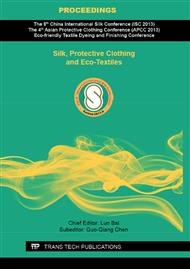p.360
p.364
p.370
p.374
p.380
p.385
p.390
p.395
p.400
Preparation of Hydroxypropyl Chitosan Nanoparticles and their Application in Antheraea Pernyi Silk Treatment
Abstract:
In this work, a water soluble chitosan derivative, hydroxypropyl chitosan (HCS) of low molecular weigh was synthesized with chitosan and epoxypropane under the alkaline condition by the heterogeneous reaction. HCS nanoparticles was further prepared through ion-gel technologies. The particles were characterized in terms of size and surface charge measurement, and both analysis showed nanoparticles of mean hydrodynamic diameter around 40 nm and positive zeta potential value +41.7 mV. When the HCS nanoparticles were applied to Antheraea pernyi (A. perny) silk fabric treatment in the presence of 1,2,3,4-butane tetracarboxylic acid and sodium hypophosphite by a conventional pad-dry-cure process, the antibacterial properties of treated fabrics were evaluated against test bacteria S. aureus and E . coli according to the American Association of Textile Chemists and Colorists (AATCC) method. The results indicated that the HCS nanoparticles treated fabric showed over 95% bacterial reduction before laundering and over 90% bacterial reduction even after 20 and 50 launderings against S. aureus and E. coli. The treatment of A. pernyi silk fabric with HCS nanoparticles also strengthened the wrinkle resistant property. Moreover, the treated A. pernyi silk fabric was also given durable wrinkle resistant property even after 20 and 50 launderings. The whiteness of the silk fabric changed a little.
Info:
Periodical:
Pages:
380-384
Citation:
Online since:
September 2013
Authors:
Price:
Сopyright:
© 2013 Trans Tech Publications Ltd. All Rights Reserved
Share:
Citation:


